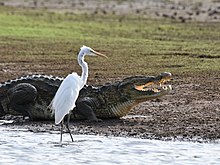
Back Archosauria Afrikaans Archosauria AN أركوصورات Arabic Archosauria AST Arxozavrlar Azerbaijani Архозаври Bulgarian Archosauria Breton Arcosaures Catalan Archosauria CEB Archosauři Czech
| Archosaurs | |||
|---|---|---|---|

| |||
| Birds and crocodilians (in this case, a great egret and a mugger crocodile) are the only living archosaur groups. | |||
| Scientific classification | |||
| Domain: | Eukaryota | ||
| Kingdom: | Animalia | ||
| Phylum: | Chordata | ||
| Class: | Reptilia | ||
| Clade: | Archosauromorpha | ||
| Clade: | Archosauriformes | ||
| Clade: | Eucrocopoda | ||
| Clade: | Archosauria Cope, 1869 | ||
| Subgroups | |||
| |||
| Synonyms | |||
| |||
Archosauria (lit. 'ruling reptiles') is a clade of diapsid sauropsid tetrapods, with birds and crocodilians being the only living representatives. Archosaurs (/ˈɑːrkəˌsɔːr/[3]) are broadly classified as reptiles, in the cladistic sense of the term, which includes birds. Extinct archosaurs include non-avian dinosaurs, pterosaurs and extinct relatives of crocodilians. Modern paleontologists define Archosauria as a crown group that includes the most recent common ancestor of living birds and crocodilians, and all of its descendants. The base of Archosauria splits into two clades: Pseudosuchia, which includes crocodilians and their extinct relatives; and Avemetatarsalia, which includes birds and their extinct relatives (such as non-avian dinosaurs and pterosaurs).[4]
Older definitions of the group Archosauria rely on shared morphological characteristics, such as an antorbital fenestra in the skull, serrated teeth, and an upright stance. Some extinct reptiles, such as proterosuchids and euparkeriids, also possessed these features yet originated prior to the split between the crocodilian and bird lineages. The older morphological definition of Archosauria nowadays roughly corresponds to Archosauriformes, a group named to encompass crown-group archosaurs and their close relatives.[4] The oldest true archosaur fossils are known from the Early Triassic period, though the first archosauriforms and archosauromorphs (reptiles closer to archosaurs than to lizards or other lepidosaurs) appeared in the Permian. Archosaurs quickly diversified in the aftermath of the Permian-Triassic mass extinction (~252 Ma), becoming the largest and most ecologically dominant terrestrial vertebrates from the Middle Triassic period up until the K-Pg mass extinction (~66 Ma).[5] Birds and several crocodyliform lineages were the only archosaurs to survive the K-Pg extinction, rediversifying in the subsequent Cenozoic era. Birds in particular have become among the most species-rich groups of terrestrial vertebrates in the present day.
- ^ Richard J. Butler; Stephen L. Brusatte; Mike Reich; Sterling J. Nesbitt; Rainer R. Schoch; Jahn J. Hornung (2011). "The sail-backed reptile Ctenosauriscus from the latest Early Triassic of Germany and the timing and biogeography of the early archosaur radiation". PLOS ONE. 6 (10): e25693. Bibcode:2011PLoSO...625693B. doi:10.1371/journal.pone.0025693. PMC 3194824. PMID 22022431.
- ^ Foth, C.; Ezcurra, M. D.; Sookias, R. B.; Brusatte, S. L.; Butler, R. J. (2016). "Unappreciated diversification of stem archosaurs during the Middle Triassic predated the dominance of dinosaurs". BMC Evolutionary Biology. 16 (1). Christian Foth, Martín D. Ezcurra, Roland B. Sookias, Stephen L. Brusatte and Richard J. Butler.: 188. Bibcode:2016BMCEE..16..188F. doi:10.1186/s12862-016-0761-6. PMC 5024528. PMID 27628503.
- ^ "Archosaur Definition & Meaning". Dictionary.com. Retrieved 2022-03-01.
- ^ a b Cite error: The named reference
NSJ11was invoked but never defined (see the help page). - ^ Ezcurra, M. N. D.; Scheyer, T. M.; Butler, R. J. (2014). "The Origin and Early Evolution of Sauria: Reassessing the Permian Saurian Fossil Record and the Timing of the Crocodile-Lizard Divergence". PLOS ONE. 9 (2): e89165. Bibcode:2014PLoSO...989165E. doi:10.1371/journal.pone.0089165. PMC 3937355. PMID 24586565.
© MMXXIII Rich X Search. We shall prevail. All rights reserved. Rich X Search